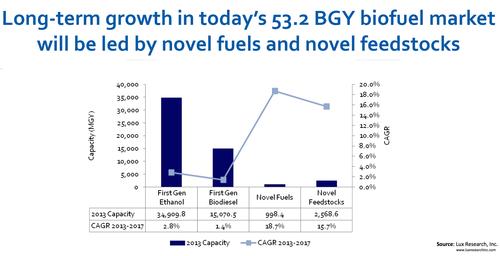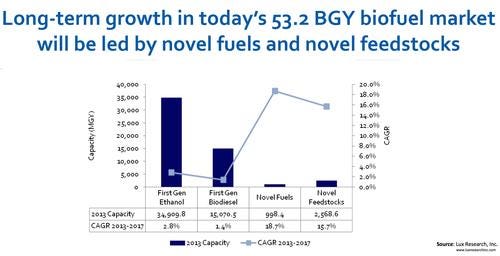Report: Biofuels in Transition to Next-Gen Feedstocks Will Slow Growth
March 31, 2014

The good news about the biofuels industry is that it's about to make the transition to next-generation, non-food-based feedstocks. The bad news is, this transition will slow capacity growth by a lot. But notice that means growth slows, not that capacity itself declines.
The news comes from a new report from Lux Research, "Emerging Feedstocks and Fuels Spark Biofuel Capacity Expansion Through 2017." It says that, between 2013 and 2017, the industry's growth rate will slow to 3.2% from the historically high growth rate of 19.6% it's enjoyed since 2005. In terms of quantity, that means it will grow from 53.2 billion gallons per year (BGY) in 2013 to 60.4 BGY in 2017.
New, higher-yielding fuels include renewable diesel, as well as butanol. As we told you recently, renewable diesel is chemically different from biodiesel. Along with butanol, it can offer higher blend ratios than first-generation food-based ethanol and vegetable oil-based biofuels like biodiesel. That's one reason for the transition to second-generation feedstocks like cellulosic biomass and waste oils. Another reason for the transition is to avoid the problems associated with first-generation feedstocks that are based either on food crops or on non-food crops that compete for water or land use with food crops.

Those second-generation feedstocks aren't mature yet, but they will be able to help realize long-term expansion in biofuels capacity, said Andrew Soare, lead author of the report and a senior analyst with Lux Research, in a press release. "Next-generation feedstocks like waste oils and cellulosic biomass are not tied up in the food supply and could unlock significant economic advantages, assuming novel conversions commercialize," he said.
Soare and other Lux Research analysts built a database of more than 1,700 biofuel production facilities in 82 countries, including capacity data through 2017. This made several things clear, including the nearly 20% growth rate. The data also revealed that ethanol represented 65.9% of global biofuel capacity in 2013, but will only rise to 66.0% in 2017. First-generation biodiesel added up to slightly less than half that amount at 17.1 BGY, and will reach 18.6 BGY in 2017. Of total global ethanol production today, 81.9% is based on corn and soy feedstocks, while 62.1% of biodiesel is based on rapeseed, palm, and soy feedstocks.
Predicting what will happen with next-generation biofuels based on novel feedstocks is more of a challenge. New renewable diesel, butanol, biojet, and biocrude, along with other fuels, constitute 1.9% of global biofuel capacity. The analysts concluded that they will grow at a much faster rate than first-generation fuels, at an annual growth rate of 18.7% from now through 2017, raising capacity share to 3.3%.
Renewable diesel will lead the fuels pack, while next-generation feedstock capacity growth will be dominated by cellulosic biomass and waste oils. Renewable diesel from waste will become a key biofuel process. Producers of butanol and biocrude will have a minor effect on overall biofuel capacity. Producers of cellulosic ethanol have announced a capacity of 782 millions of gallons per year (MGY), but in the study analysts said they actually expect only 384 MGY to be made.
Related posts:
About the Author(s)
You May Also Like



